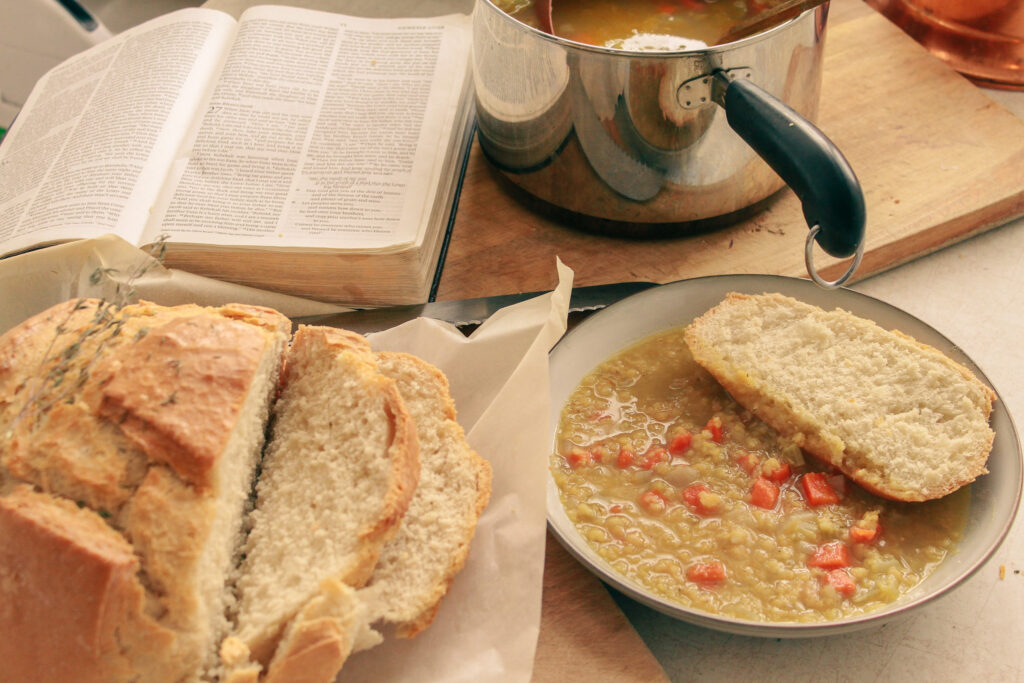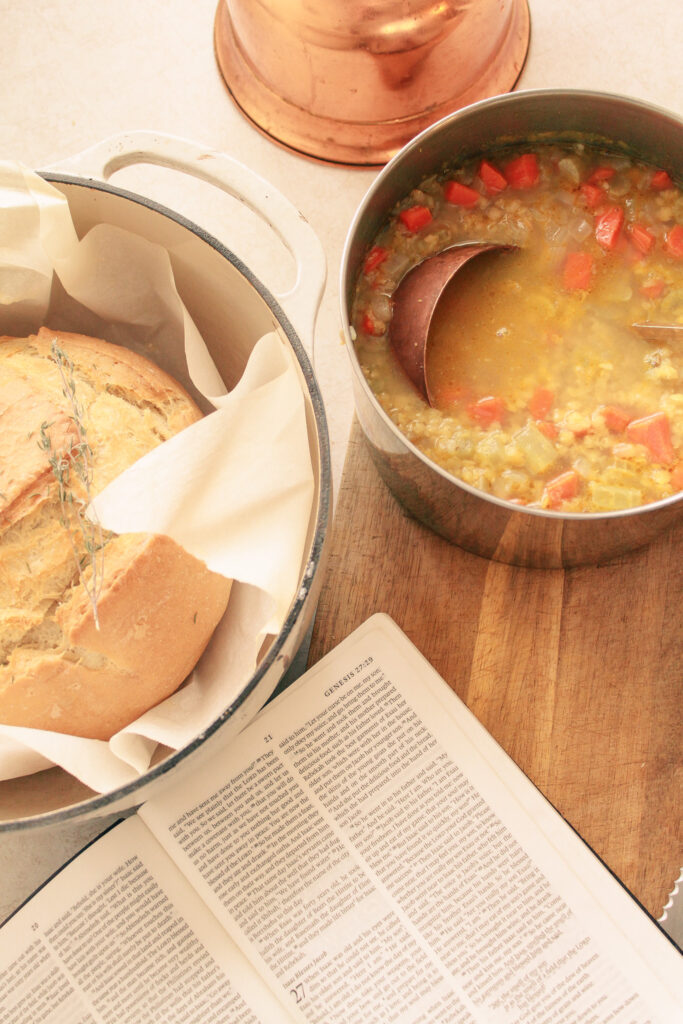
History
The recipe associated with the commemoration of St. Jacob on February 5th comes directly from Scripture. In Genesis 25:32-34 we hear one of the most pivotal moments of Jacob’s story: Esau selling his birthright to Jacob for a piece of bread and lentil stew.
The stew must have been especially delicious since Esau was so quick to give up his status as the firstborn! While we don’t know the exact recipe, of course, it is fun to speculate on what the food might have consisted of and why it was so tempting for the older brother. Just like other Old Testament saints who had stew as part of their stories (St. Isaiah and St. Elisha), St. Jacob’s stew is one of the most famous instances of delicious cooking in the Bible.
While we have to guess why exactly this stew convinced Esau to discard his birthright, we do know one thing: the reason why this food was a lentil stew is widely believed to have some connection to the death of Abraham, as it was a Jewish tradition to eat lentils in times of mourning. We know that Isaac, Esau and Jacob’s dad, was lamenting the passing of his father, the great patriarch, during the time of the birthright trade. The eating of lentils in the household makes sense. Plus, the lentil connection can have a double meaning, too, since the trade for the stew also naturally caused great consternation and anguish for Esau, who was so angry at Jacob that he sought to kill him, causing Jacob to flee his homeland.


Bread & Red Lentil Stew
Lentils were an important part of the typical Biblical diet: they are mentioned four times in the Bible and were seasoned with the spices of the Middle East to make satisfying dishes. Carrots, celery, and onion would have also been used in Old Testament times as well as spices such as cilantro, cumin, parsley, and bay leaves, to name a few.
Our recipe features some of these, staying true to what would have been authentic for Jacob’s time. One ingredient that has to be speculated on, though, is what made the stew “red.” While red lentils are a good option for the recipe, they are brown when cooked and don’t provide a very vibrant color. Other spices that would provide a red color are either hard to find or probably wouldn’t have been used during that time period, like paprika. Some guess sumac, which you can use if you have access to it. However, due to its limited availability we didn’t include it in this rendition. Thus, this stew isn’t very “red” upon first glance, but it still includes some of that idea with the ingredients that are featured.
In terms of the bread that Jacob gave Esau, it is no surprise that this food was a staple of Old Testament diets. While we again can only guess what the biblical recipe consisted of, it was likely an earthy bread recipe that would have gone great with soup. Our own variation is a favorite in our houses and one that we believe also compliments the stew—plus it is easy to make up for a quick dinner at home in commemoration of St. Jacob, the third patriarch.

Red Lentil Stew
Ingredients
1 bunch fresh cilantro
3 carrots, chopped
3 celery stalks, chopped
1 red onion, diced
3 garlic cloves, minced
2 tablespoons extra virgin olive oil
2 cups red lentils
1 teaspoon cumin
1 teaspoon parsley
1 bay leaf
1 teaspoon salt
½ teaspoon black pepper
8 C bone broth
Instructions
- Roughly chop the carrots, celery, onion, and cilantro bunch. In a medium pot, heat olive oil over medium heat. Cook onion until translucent and add in the carrots, celery, onion, and garlic, sautéing until caramelized.
- Add lentils and dried spices to the pot along with the bone broth. Bring to a boil and reduce heat to a simmer. Finally add half of the cilantro to the pot, simmering 30 minutes until lentils are soft. Garnish with remaining cilantro and serve with bread.
St. Jacob Red Lentil Stew
Ingredients
- 1 bunch fresh cilantro
- 3 carrots chopped
- 3 celery stalks chopped
- 1 red onion diced
- 3 garlic cloves minced
- 2 tbsp extra virgin olive oil
- 2 C red lentils
- 1 tsp cumin
- 1 tsp parsley
- 1 bay leaf
- 1 tsp salt
- ½ tsp black pepper
- 8 C bone broth
Instructions
- Roughly chop the carrots, celery, onion, and cilantro bunch. In a medium pot, heat olive oil over medium heat. Cook onion until translucent and add in the carrots, celery, onion, and garlic, sautéing until caramelized.
- Add lentils and dried spices to the pot along with the bone broth. Bring to a boil, stir, and reduce heat to a simmer. Finally add half of the cilantro to the pot, simmering 30 minutes or until lentils are soft. Remove the bay leaf and garnish with remaining cilantro and serve with bread.
Stew Loaf
Ingredients
1 cup water, warm to touch
2 teaspoons active dry yeast
1 teaspoon salt
¼ cup olive oil
2 ¾ – 3 cups all purpose flour
1 teaspoon thyme (optional)
1 teaspoon minced garlic (optional)
Instructions
- Combine the warm water (warm to the touch but not hot) and the yeast in the bowl of a stand mixer. Let it rest for 5 minutes and then add the salt, oil, and 1 cup of the flour. Give the mixture a stir and add additional herbs and seasonings, if desired, such as 1 teaspoon minced garlic and 1 teaspoon of herbs of choice.
- While mixing, slowly add the remaining flour and continue mixing for 5 minutes.
- Remove the dough and knead it into a smooth ball. Place the dough in a greased bowl and cover. Let it rise until doubled.
- Once doubled, punch down the dough and reshape into a round loaf. Place the loaf on a piece of parchment paper and allow it to double in size again. During this time, place a dutch oven into the oven at 400 degrees Fahrenheit and allow both to preheat while the dough rises.
- When the oven reaches temperature, take a sharp knife and make cuts into the loaf about ¼” deep in the shape of an “X” or a square to allow the dough to rise in the oven.
- Lifting the dough by the parchment paper, place the loaf in the preheated dutch oven, cover, and bake for 30 minutes. Remove the lid and bake for 20-30 more minutes until the top is a deep golden brown color.
- Remove it from the oven and let it cool before slicing and enjoying with the stew.
Rustic Stew Loaf
Ingredients
- 1 C water warm to touch
- 2 tsp active dry yeast
- 1 tsp salt
- ¼ C olive oil
- 2 ¾ – 3 C all purpose flour
- 1 tsp thyme optional
- 1 tsp minced garlic optional
Instructions
- Combine the warm water (warm to the touch but not hot) and the yeast in the bowl of a stand mixer. Let it rest for 5 minutes and then add the salt, oil, and 1 cup of the flour. Give the mixture a stir and add additional herbs and seasonings, if desired, such as 1 teaspoon minced garlic and 1 teaspoon of herbs of choice.
- While mixing, slowly add the remaining flour and continue mixing for 5 minutes.
- Remove the dough and knead it into a smooth ball. Place the dough in a greased bowl and cover. Let it rise until doubled.
- Once doubled, punch down the dough and reshape into a round loaf. Place the loaf on a piece of parchment paper and allow it to double in size again. During this time, place a dutch oven into the oven at 400 degrees Fahrenheit and allow both to preheat while the dough rises.
- When the oven reaches temperature, take a sharp knife and make cuts into the loaf about ¼" deep in the shape of an "X" or a square to allow the dough to rise best in the oven.
- Lifting the dough by the parchment paper, place the loaf in the preheated dutch oven, cover, and bake for 30 minutes. Remove the lid and bake for 20-30 more minutes until the top is a deep golden brown color.
- Remove it from the oven and let it cool before slicing and enjoying with the stew.

